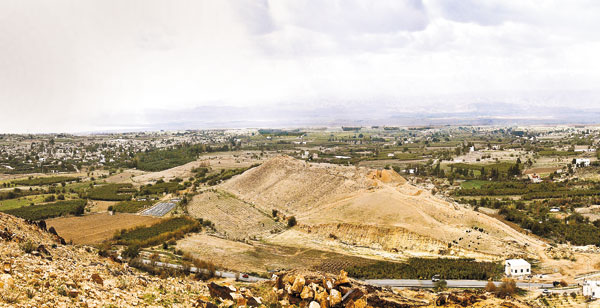Where Is Sodom?
Genesis 13, archaeology and Biblical geography provide clues
According to the Bible, “the men of Sodom were wicked” (Genesis 13, verse 13). For its many sins, God destroyed Sodom and all the inhabitants of the “cities of the plain” in an intense conflagration, but not before allowing Abraham’s nephew Lot and his family to flee to safety.
The stories of Sodom and its destruction, whether historical or not, were clearly understood to have occurred near the Dead Sea, among the so-called “cities of the plain” mentioned in Genesis 13, verse 12. But where exactly was this plain, and was a particular site associated with Sodom? In the article “Where Is Sodom?” in the March/April 2013 issue of BAR, archaeologist Steven Collins combines clues from Biblical geography with archaeological evidence from the site of Tall el-Hammam in Jordan to suggest that the author of Genesis 13 located Sodom in a fertile area northeast of the Dead Sea.


In the article “Where Is Sodom?” archaeologist Steven Collins, using clues from the Biblical geography of Genesis 13 together with archaeological evidence from the site of Tall el-Hammam (pictured), argues that Biblical tradition located Sodom in a fertile area northeast of the Dead Sea. Photo: Michael C. Luddeni.
So where is Sodom, according to the Biblical geography of Genesis 13? Sodom and its sister cities are located in the large oval-shaped, fertile plain just north of the Dead Sea called simply ha-kikkar, or “the Disk” (Genesis 13, verse 13). In Biblical geography, this well-watered disk-shaped plain, said to have been located east of the highland towns of Bethel and Ai, was an area “like the garden of the Lord, like the land of Egypt” where Lot moved his family after his quarrel with Abraham (Genesis 13, verse 10). It is also the place where the Biblical writers set their dramatic tale of Sodom’s wickedness and destruction (Genesis 19).
Other than Israel, no country has as many Biblical sites and associations as Jordan: Mount Nebo, from where Moses gazed at the Promised Land; Bethany beyond the Jordan, where John baptized Jesus; Lot’s Cave, where Lot and his daughters sought refuge after the destruction of Sodom and Gomorrah; and many more. Travel with us on our journey into the past in our free eBook Exploring Jordan.
Seeking to answer the question “Where is Sodom?” and using the Biblical geography of Genesis 13 as a guide, Collins decided to excavate Tall el-Hammam, an extensive and heavily fortified site located in modern Jordan at the eastern edge of the kikkar. First inhabited during the Chalcolithic period (4600–3600 B.C.E.), the site attained its maximum size during the Middle Bronze Age (c. 2000–1600 B.C.E.) and became one of the largest cities in Canaan. But unlike other Canaanite cities that continued to flourish in the Late Bronze Age (1550-1200 B.C.E.), Tall el-Hammam was destroyed by fire at the end of the Middle Bronze Age and remained uninhabited for centuries.
Read responses by scholars Bill Schlegel and Todd Bolen regarding the location of Sodom.
Across Tall el-Hammam, archaeologists found widespread evidence of an intense conflagration that left the Middle Bronze Age city in ruins. They found scorched foundations and floors buried under nearly 3 feet of dark grey ash, as well as dozens of pottery sherds covered with a frothy, “melted” surface; the glassy appearance indicates that they were briefly exposed to temperatures well in excess of 2,000 degrees Fahrenheit, the approximate heat of volcanic magma. Such evidence suggests the city and its environs were catastrophically destroyed in a sudden and extreme conflagration.
Was it this event—which destroyed Hammam and the other cities of the kikkar—that was remembered by the Biblical writers in their telling of the story of Sodom?
——————BAS Library Members: Read the full article “Where Is Sodom?” by Steven Collins in Biblical Archaeology Review, March/April 2013.
Not a BAS Library member yet? Sign up today!
This Bible History Daily feature was originally published on February 20, 2013.
Related reading in Bible History Daily:
Locating Zoar
Steven Collins responds to a letter by Bill Schlegel
Arguments Against Locating Sodom at Tall el-Hammam
Todd Bolen responds to “Where is Sodom”
Lot’s Cave Museum at Ancient Zoar (Zoora)
Get more biblical Archaeology: Become a Member
The world of the Bible is knowable. We can learn about the society where the ancient Israelites, and later Jesus and the Apostles, lived through the modern discoveries that provide us clues.
Biblical Archaeology Review is the guide on that fascinating journey. Here is your ticket to join us as we discover more and more about the biblical world and its people.
Each issue of Biblical Archaeology Review features lavishly illustrated and easy-to-understand articles such as:
• Fascinating finds from the Hebrew Bible and New Testament periods
• The latest scholarship by the world’s greatest archaeologists and distinguished scholars
• Stunning color photographs, informative maps, and diagrams
• BAR’s unique departments
• Reviews of the latest books on biblical archaeology
The BAS Digital Library includes:
• 45+ years of Biblical Archaeology Review
• 20+ years of Bible Review online, providing critical interpretations of biblical texts
• 8 years of Archaeology Odyssey online, exploring the ancient roots of the Western world in a scholarly and entertaining way,
• The New Encyclopedia of Archaeological Excavations in the Holy Land
• Video lectures from world-renowned experts.
• Access to 50+ curated Special Collections,
• Four highly acclaimed books, published in conjunction with the Smithsonian Institution: Aspects of Monotheism, Feminist Approaches to the Bible, The Rise of Ancient Israel and The Search for Jesus.
The All-Access membership pass is the way to get to know the Bible through biblical archaeology.

